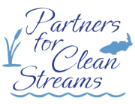 You better be-leaf it! Fall leaves that wash into stormwater are a contributor to excess nutrients in our Great Lakes. Learn how changes to your yard practices can make a positive difference this autumn.
You better be-leaf it! Fall leaves that wash into stormwater are a contributor to excess nutrients in our Great Lakes. Learn how changes to your yard practices can make a positive difference this autumn.
How big of a deal can autumn leaves be for our waterways? After all, leaves are all-natural!
At the simplest level, leaf litter in storm drains blocks the flow of water. This means enough leaf litter piled in curbs or covering drains can cause roads to flood. Leaves can also cause blockages inside a drain and damage our local pipes. However, there’s more to the story.
Decaying leaves are full of nutrients, especially phosphorous. In environments like forests, prairies, and wetlands, soil and plants absorb these extra nutrients and they go on to become plant food. However, cities are full of hard surfaces like streets, parking lots, and buildings. Leaves still fall, but there’s nowhere for those nutrients to go besides getting washed into stormwater. Stormwater is untreated, meaning it flows directly from your street into a local ditch or stream, into a larger waterway like Swan Creek, the Ottawa River, or the Maumee River, and ultimately out into Lake Erie. That means all the nutrients that would sink into the soil of a forest instead get channeled right into our Great Lakes, contributing to algal blooms.
It turns out that the nutrients from municipal leaves have a big impact on our Great Lakes. A 2016 study in Madison, Wisconsin found that timely autumn leaf removal can reduce harmful phosphorus in stormwater by over 80 percent!
Taking care of your autumn leaves can save you money and time spent on your yard, help your municipality take care of its stormwater, and help Lake Erie’s nutrient levels all at the same time. Here are our leaf tips this autumn:
- Use a lawnmower to mulch the leaves on your lawn. Leave them in place or put them on your garden beds. The nutrients from leaves create free fertilizer for your plants to use.
- If you want to rake your leaves for municipal collection, make sure to keep leaf piles out of the curb and away from storm drains. If your street has a sidewalk, between the street and the sidewalk is the sweet spot.
- If you remove your own leaves to take them to be composted, temporarily bagging them reduces the chances that leaves will get loose and pollute our waterways.
- Adopt a storm drain. You can take responsibility for storm drains near your home or workplace and get into the habit of making sure they’re free from leaves, trash, and other debris. Learn more on adopting storm drains from Clear Choices, Clean Water Toledo-Lake Erie.
